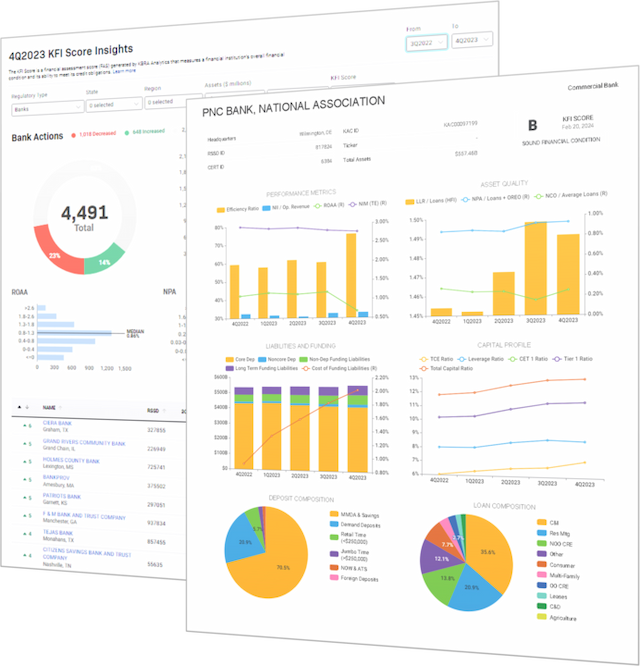KBRA Financial Intelligence
Mapping the Banks Facing Disaster Exposure as Hurricanes Slam U.S. Southeast
By KFI Staff
Between September 26 and October 2, all 372 counties across Alabama, Georgia, North Carolina, and South Carolina, as well as 31 more in portions of Florida and Tennessee, were declared to be experiencing a disaster by the Federal Emergency Management Agency (FEMA). Hurricane Helene has ripped through each of those six states, leaving a trail of destruction in its path. Disasters can be segmented on a county-by-county basis and are denoted as either an emergency declaration (EM) or major disaster declaration (DR) by FEMA, with the latter being a more severe categorization. Throughout the total impacted area, 110 counties in disaster (27.36% of the total) were classified as DR.
In addition to the tragic human cost many communities face, banks with a significant presence in affected areas may have to manage indefinite operational costs and risks to their lending portfolios. Commercial real estate (CRE) loans could be particularly exposed to physical damage caused by wind, flooding, and other natural disaster-related concerns. These properties may see reduced cash flow from the downtime needed to complete repairs, further complicating their borrowers’ repayments.

By cross-referencing FEMA’s information with KFI’s dataset, we have mapped out all impacted counties across six Southeastern U.S. states to plot the path of Helene and identify which of these areas have the highest number of physical bank locations. Florida’s Hillsborough County was declared to be in a state of disaster recovery on September 28 and has the highest population of bank branches among all impacted counties at 254. The next highest was Fulton County, Georgia, home to 244 bank offices. North Carolina’s Mecklenburg and Wake Counties are tied in fourth place with 240 locations.
Using KFI’s platform to create customized deposit summary reports across multiple states at the county level, we generated and analyzed a multistate perimeter of the 403 counties under a FEMA disaster declaration as a single body. Within this area, which we will refer to as the “impact zone,” our analysis concludes that Bank of America, National Association (KFI Score: B) was the leading institution in custody of deposits, carrying a 28.96% market share. Truist Bank (KFI Score: B) had the largest physical footprint within the counties at 769 branches. That portion of Truist branches represents 39.82% of all the bank’s offices in the U.S., making its branch concentration within the impact zone more than triple that of BofA. Both of those banks are headquartered in North Carolina. By many accounts, the western portion of North Carolina was among the areas most devastated by Hurricane Helene. As of 2Q 2024, BofA maintained 108 office locations in the state and lead all other banks in its market share of North Carolina deposit holdings at 48.92%. These in-state deposits represent 17.84% of the bank’s total deposits.

KFI’s interactive deposit map can be used to visualize the geographic layout of bank branches across the country or within specific regions. Multiple institutions can be added to these maps at the same time, allowing users to compare the presence of large, federally-chartered institutions like BofA against more localized, state-chartered competitors. Although BofA has saturated the metropolitan areas of central and eastern North Carolina, its offices are more sparse in the harder-hit western third of the state (such as the Asheville region), where branches of regional depositories like HomeTrust Bank (KFI Score: B) and First Bank (KFI Score: B+) are more prevalent. Additionally, 2Q call report data indicates both of those banks are more heavily exposed to non-owner occupied CRE than any other loan category at 35.07% and 47.23% of total lending, respectively. Community and regional banks generally appear more likely to experience potential financial degradation resulting from Hurricane Helene. More than two-thirds of 463 banking institutions with offices in impact zone counties have more than 90% of deposits and/or branch locations concentrated within the perimeter.

Although only 34.33% of Florida counties were declared to be experiencing a disaster in the aftermath of Helene, every one of these impacted jurisdictions was categorized as DR. That meant Florida led all six analyzed states in the share of counties declaring a major disaster. This is a concerning prospect, as this region could be slammed by yet another major storm this week. Hurricane Milton, now moving eastward through the Gulf of Mexico, has recently strengthened to a category 5 hurricane and is expected to make landfall on Wednesday. KFI will monitor this situation as it develops. KFI Pro subscribers can take a deeper look into the composition of Florida’s market for banking services by using our Deposit Summary tool to generate and download regional deposit composition reports on a statewide or county-by-county basis. In addition, our screener tool can be used to identify groupings of locally headquartered financial institutions in any state, segmented by assets, equity, KFI Score, and a variety of other financial characteristics. To further understand how your organization can leverage our financial assessment scores and cutting-edge data tools, request a demo with KFI today.

